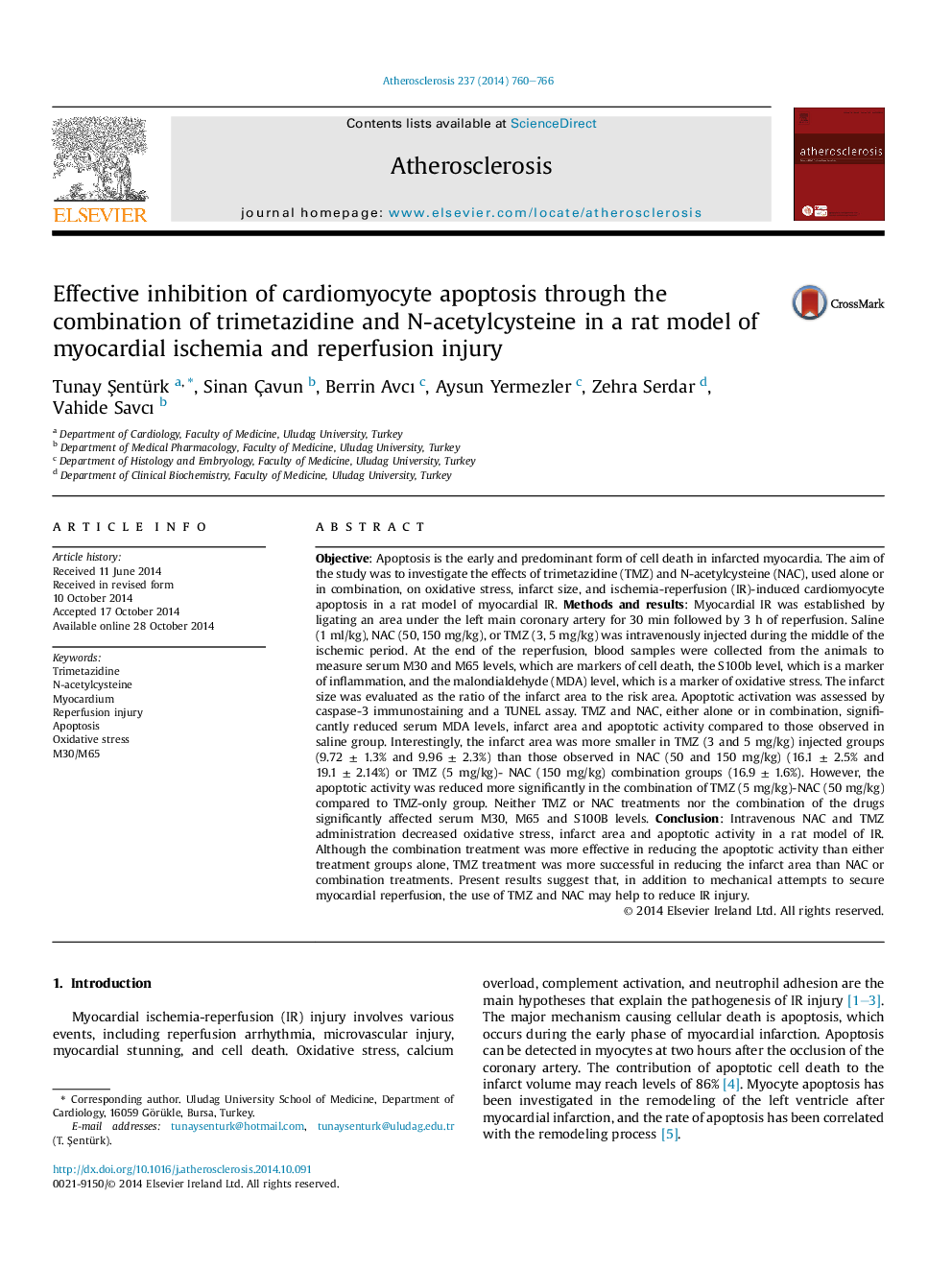| کد مقاله | کد نشریه | سال انتشار | مقاله انگلیسی | نسخه تمام متن |
|---|---|---|---|---|
| 5945288 | 1172350 | 2014 | 7 صفحه PDF | دانلود رایگان |
- Apoptosis is the early and predominant form of cell death in infarcted myocardium.
- Trimetazidine (TMZ), shifts myocardial energy metabolism from fatty acid to glucose oxidation.
- N-acetylcysteine (NAC) increases the intracellular cysteine concentration and the concentration of reduced glutathione.
- Intravenous NAC and TMZ administration decreases oxidative stress, infarct area, and apoptotic activity.
- The combination of TMZ and NAC may help to reduce IR injury.
Objective: Apoptosis is the early and predominant form of cell death in infarcted myocardia. The aim of the study was to investigate the effects of trimetazidine (TMZ) and N-acetylcysteine (NAC), used alone or in combination, on oxidative stress, infarct size, and ischemia-reperfusion (IR)-induced cardiomyocyte apoptosis in a rat model of myocardial IR. Methods and results: Myocardial IR was established by ligating an area under the left main coronary artery for 30 min followed by 3 h of reperfusion. Saline (1 ml/kg), NAC (50, 150 mg/kg), or TMZ (3, 5 mg/kg) was intravenously injected during the middle of the ischemic period. At the end of the reperfusion, blood samples were collected from the animals to measure serum M30 and M65 levels, which are markers of cell death, the S100b level, which is a marker of inflammation, and the malondialdehyde (MDA) level, which is a marker of oxidative stress. The infarct size was evaluated as the ratio of the infarct area to the risk area. Apoptotic activation was assessed by caspase-3 immunostaining and a TUNEL assay. TMZ and NAC, either alone or in combination, significantly reduced serum MDA levels, infarct area and apoptotic activity compared to those observed in saline group. Interestingly, the infarct area was more smaller in TMZ (3 and 5 mg/kg) injected groups (9.72 ± 1.3% and 9.96 ± 2.3%) than those observed in NAC (50 and 150 mg/kg) (16.1 ± 2.5% and 19.1 ± 2.14%) or TMZ (5 mg/kg)- NAC (150 mg/kg) combination groups (16.9 ± 1.6%). However, the apoptotic activity was reduced more significantly in the combination of TMZ (5 mg/kg)-NAC (50 mg/kg) compared to TMZ-only group. Neither TMZ or NAC treatments nor the combination of the drugs significantly affected serum M30, M65 and S100B levels. Conclusion: Intravenous NAC and TMZ administration decreased oxidative stress, infarct area and apoptotic activity in a rat model of IR. Although the combination treatment was more effective in reducing the apoptotic activity than either treatment groups alone, TMZ treatment was more successful in reducing the infarct area than NAC or combination treatments. Present results suggest that, in addition to mechanical attempts to secure myocardial reperfusion, the use of TMZ and NAC may help to reduce IR injury.
Journal: Atherosclerosis - Volume 237, Issue 2, December 2014, Pages 760-766
